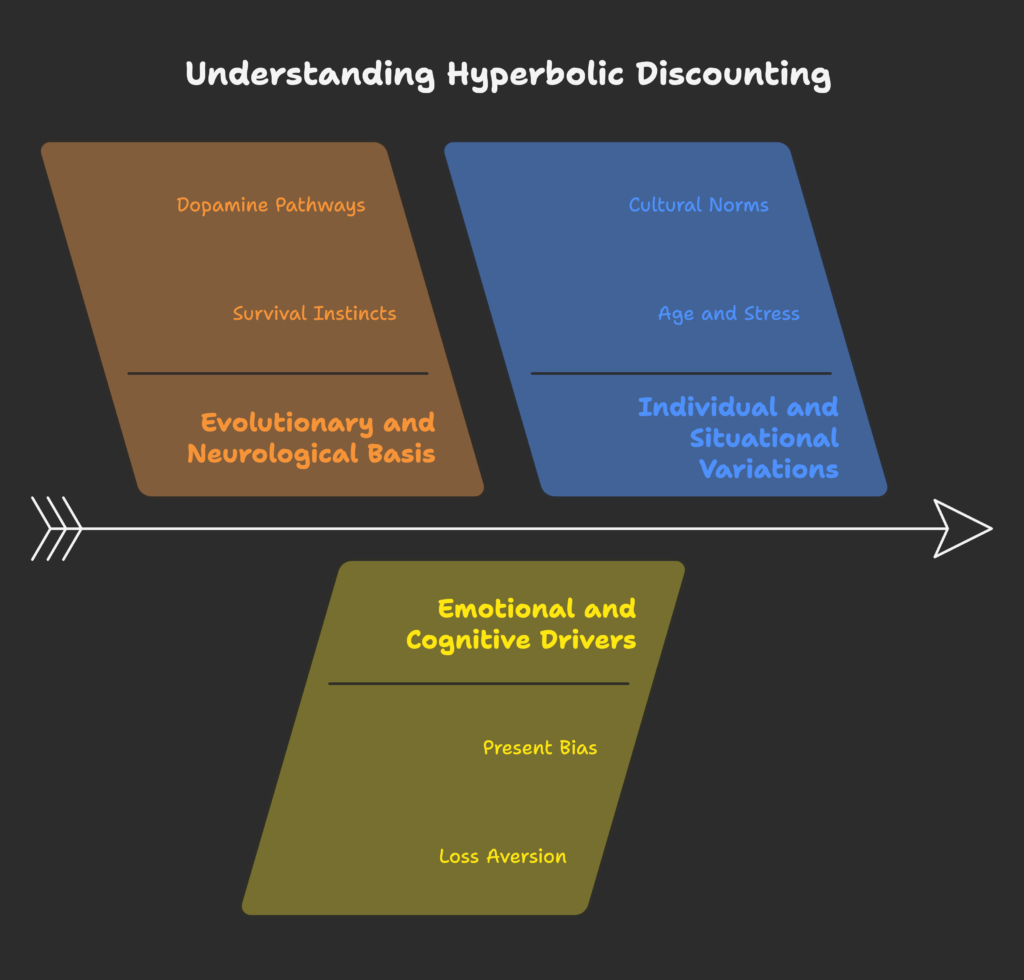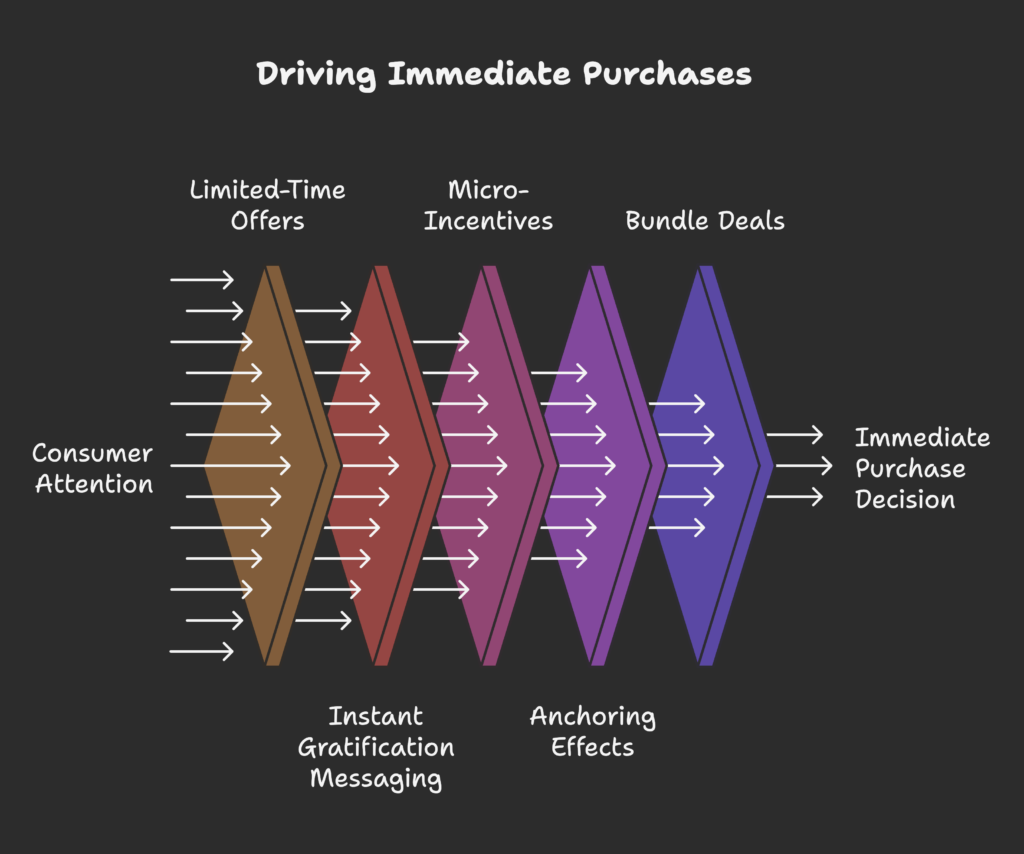Have you ever chosen a smaller reward now instead of a bigger reward you could get in a few weeks, even though you knew the bigger reward was a better deal? Welcome to hyperbolic discounting – the tendency to favor immediate rewards over larger, future ones. By reading this article, you’ll uncover why this mental shortcut is so common and how marketers use it to boost conversions. Ready to see why “now” beats “later” in e-commerce? Let’s jump in!
In this section: We’ll define hyperbolic discounting, look at its evolutionary roots, and see how it impacts shopping decisions. You’ll learn the difference between this behavior and traditional (exponential) discounting, and understand how it shapes consumer preferences for instant benefits over delayed savings.
Definition and Conceptual Framework
Hyperbolic discounting is a cognitive bias where people heavily discount the value of future rewards and strongly favor immediate payoffs. The discounting curve is “hyperbolic” because as time moves forward, the perceived value of that future reward drops steeply. It’s thought to stem from survival instincts: better to grab resources now when they’re certain than risk not getting them later. However, this bias often leads to *poor financial decisions*, like impulse buying or skipping long-term savings.
Behavioral Economics Context
Classical economic models assume *exponential discounting*, where people value future benefits consistently over time. Reality looks different. Hyperbolic discounting reveals *time-inconsistent preferences* – we plan to save tomorrow but yield to temptation today. It shows up in everyday life, from failing to stick to a diet to overspending during online sales. In fact, around 68% of consumers polled say they’ll choose a smaller immediate deal over a bigger discount if they have to wait.
The Conversion Advantage of Immediate Rewards
E-commerce and marketing experts leverage hyperbolic discounting with flash sales, limited-time offers, and immediate gratification. Offering a discount valid *today only* can triple response rates because it hits that impulsive part of our brain seeking rewards right now. By contrasting a big future saving with a smaller but instant deal, you can significantly drive conversions, thanks to the brain’s craving for immediate dopamine hits.
Now that we know what hyperbolic discounting is, let’s explore its psychological underpinnings – from brain circuits to emotional triggers that make us pick instant benefits over future wins.
Psychological Foundations of Hyperbolic Discounting
In this section: We’ll see how evolution and neuroscience created a bias toward “now,” examine the emotional drivers behind it, and explore why waiting for bigger rewards often feels so hard.

Evolutionary and Neurological Basis
Our ancestors lived in uncertain environments, so acting on immediate resources was key to survival – hoarding for tomorrow meant risking that tomorrow might never come. Neurologically, *dopamine pathways* reward immediate gratification. The prefrontal cortex, which helps us plan and postpone impulses, is sometimes overruled by deeper, older brain structures wired for “must have it now.” Meanwhile, if a reward is delayed, we perceive it as uncertain, lowering its mental value.
Emotional and Cognitive Drivers
- Present Bias: We place extra emotional weight on what we can get right away.
- Loss Aversion: Missing out *now* can feel like a sure loss, whereas future gains are intangible.
- Temporal Framing: Describing a reward as immediate triggers positive excitement, while “later” is overshadowed by procrastination or doubt.
The interplay of these factors leads to short-term choices that can override logical, long-term thinking.
Individual and Situational Variations
Some groups are more prone to impulsivity – for example, younger people or those under stress may prioritize immediate gratification. Cultural norms also play a role: societies that value instant enjoyment might see even stronger hyperbolic discounting behaviors. Additionally, *context matters*. When people are tired or financially constrained, they often pick “now” over waiting, fueling quick but sometimes regrettable buys.
We’ve explored the psychology. Next, let’s see how these principles impact online conversion optimization, from limited-time discounts to micro-rewards that spur immediate action.
Hyperbolic Discounting in Conversion Optimization
In this section: We’ll see how digital marketers and product managers harness immediate-reward tactics, design promotions that highlight instant benefits, and leverage users’ impulsive side to nudge purchases.

Immediate Rewards as Conversion Drivers
- Limited-Time Offers: By giving a short window (24-hour flash sale), you hook shoppers who hate the idea of missing out now.
- Instant Gratification Messaging: Phrases like “Get it today” or “Instant access” feed into the user’s desire for immediate outcome.
- Micro-Incentives: Small perks (like free shipping on the first item) can tip the scales in favor of an immediate buy instead of waiting.
Showing how they can gain something right now is a powerful lure, overshadowing the logic of waiting for potentially larger savings or deals.
Pricing and Promotional Strategies
- Anchoring Effects: Show the bigger future price, then highlight the immediate discount to create contrast and drive quick decisions.
- Bundle Deals: Encourage customers to buy more items *today* under the promise of a collectively bigger immediate saving, ignoring the possibility of better deals later.
- Dynamic Pricing: Adapting discounts or freebies in real time to keep the shopper engaged in the “now moment.”
All of these hinge on making the short-term reward stand out as more appealing than any uncertain future discount.
Digital Marketing Applications
Online, you can highlight instant buy triggers in:
- Email Campaigns: Subject lines with “ENDS TONIGHT!” or “Limited 2-hour free shipping.”
- Social Proof: Real-time counters or sales pop-ups showing others buying now fosters *FOMO* (fear of missing out).
- Mobile UX: Smooth, fast checkouts reduce the time a shopper has to second-guess or rationalize waiting.
These strategies collectively exploit the user’s preference for *immediate satisfaction* over the delayed alternative.
We know immediate rewards are the key. But how do different industries adopt these tactics? Let’s see real-life examples and success rates.
Industry-Specific Case Studies
In this section: We’ll explore how e-commerce, subscription services, finance, and healthcare each use hyperbolic discounting to spur immediate sign-ups, purchases, or plan upgrades.
E-commerce and Retail
- Flash Sales: Online fashion retailers running short, steep discounts (e.g., 70% off for the next 4 hours) see dramatic sales spikes due to immediate gratification triggers.
- Loyalty Programs: Starbucks, for instance, gives immediate stars or freebies, encouraging you to buy more *now* rather than focusing on long-term savings.
- Fast Shipping Promises: “Arrives tomorrow” can be more alluring than a discount that starts next week.
SaaS and Subscription Services
- Free Trial Access: Immediate function usage hooks users. They get excited about benefits now, overshadowing any plan cost in the future.
- Freemium Upgrades: Nudging people to unlock a “Pro” feature right away, playing on the frustration of waiting to see advanced features.
- Pricing Tiers with Instant Bonuses: “Sign up for annual billing *today* and get two free months upfront.”
In all these cases, emphasis on immediate utility or bonus yields higher willingness to commit now.
Financial and Healthcare Services
Even cautious industries leverage hyperbolic discounting. For example:
- High-Yield Accounts: Offering immediate interest payouts or sign-up rewards addresses the quick-gratification need.
- Health Apps: Giving daily achievements or immediate motivational nudges encourages users to keep their subscription, ignoring the rational benefits of a competitor’s cheaper but delayed-latitude plan.
- Insurance Incentives: Immediate discount on your first premium if you sign up now, overshadowing the possibility that future rates might be lower or that you could compare more providers later.
With these examples in hand, let’s address the *ethics*. After all, capitalizing on immediate desires can be beneficial, but we should also avoid misleading or pressuring consumers.
Ethical and Strategic Considerations
In this section: We’ll talk about the fine line between offering genuine immediate deals and pushing manipulative tactics. We’ll see how to maintain user trust, encourage long-term relationships, and provide real value instead of illusions of urgency.
Balancing Persuasion with User Autonomy
It’s crucial not to mislead. Offer real immediate rewards—like *authentic* discounts or free shipping upgrades—rather than inflated original prices that appear to be reduced. Consumers are more informed than ever, and losing credibility can harm your brand’s future. Show them courtesy and respect their power to choose so you don’t harm brand loyalty.
Behavioral Nudges and Interventions
If your aim is to help customers make better decisions (like saving money or adopting healthier habits), you can shape strategies that encourage short-term wins *plus* highlight the future. This might include commitment devices or progress bars that build a sense of momentum for future gains. By mixing immediate gratification with educational content, you help them avoid purely impulsive or harmful choices.
Regulatory and Policy Implications
- Consumer Protection: Some laws require clear disclaimers when using short-term discount claims or countdown timers.
- Industry Self-Regulation: Ethical guidelines ensure you’re not abusing psychological shortcuts too aggressively.
Responsible usage fosters trust and fosters an environment where customers keep coming back, not feeling tricked once the hype wears off.
Convinced enough to try? Next, we’ll see advanced tactics to push your conversion optimization further—from AI personalization to cross-channel synergy.
Advanced Strategies for Conversion Optimization
In this section: We’ll outline how AI can tailor immediate rewards, how to coordinate these incentives across multiple touchpoints, and how next-generation technologies could expand hyperbolic discounting approaches.
AI-Driven Personalization
- Predictive Offer Timing: Systems detect the perfect moment to propose an instant deal or a short discount based on user browsing patterns.
- Dynamic Pricing: Vary discount levels in real time to match each shopper’s likely discounting curve – e.g., bigger immediate cuts for those who rarely buy spontaneously.
- Personalized Messaging: “Special limited-time offer just for you” can push a user’s impulsive triggers if it resonates with their known preferences.
Cross-Channel Integration
Use consistent “Act Now” signals across email, app notifications, and website. If a user sees a fleeting discount in one channel but visits your site from another, keep that messaging consistent to maintain urgency. This synergy prevents confusion and underscores that the immediate deal is genuine across the board. Even social media retargeting can highlight that the clock is ticking on your special offer.
Future Technologies
- AR/VR Integration: Let customers “try” items in real-time. The desire to “lock in the deal” while immersed in a virtual environment can amplify immediate gratification urges.
- Voice Commerce: Alexa or Google Assistant prompting you to buy something at a discount right now, removing friction for a swift purchase decision.
These innovations continue to emphasize immediacy – the more frictionless the buy, the stronger hyperbolic discounting becomes.
Conclusion and Strategic Recommendations
In this section: We’ll recap the most critical principles, show you how to implement them responsibly, and look ahead to potential research directions. The final word: immediate payoffs do convert better, but use them wisely!
Key Takeaways for Marketers
- Highlight Instant Gains: Emphasize short-term benefits, freebies, or fast shipping in your promotions.
- Use Time Constraints: Scarcity (limited-time deals) triggers the fear of missing out, boosting impulse buys.
- Balance Ethics and Efficacy: Offer real value, not deceptive illusions. Maintain trust while using persuasive elements.
Future Research Directions
- Cultural Differences: Investigate how various cultures weigh the present vs. future in discounting contexts.
- Neuroeconomic Models: More advanced brain-imaging studies to refine how to best structure immediate offers for individuals.
- Ethical Frameworks: As harnessing hyperbolic discounting becomes easier, guidelines to prevent abuse will be increasingly essential.
Implementation Roadmap
- Audit Current Offers: Find chances to add quick gratification. Could you add a new discount or instant perk?
- A/B Test: Test immediate vs. future discount campaigns. Track if short-term promotions consistently boost conversions.
- Iterate: Let analytics guide your next set of discounts. Adjust the size, timing, and framing of immediate rewards for maximum efficacy.
Small Note: If you’re a Shopify store owner looking to leverage hyperbolic discounting effectively, consider the Growth Suite app. It helps personalize timing, highlight instant rewards, and seamlessly integrate your marketing across channels—so you can satisfy shoppers’ cravings for “now” and boost sales.
References
- Navigating Time-Inconsistent Behavior (2024) – Link
- Hyperbolic Discounting in Marketing (2023) – Link
- Quasi-Hyperbolic Discounting in Land Conversion (2012) – Link
- Instant Gratification in Marketing (2020) – Link
- Reward vs. Loss Discounting (2022) – Link
- Behavioral Economics of Hyperbolic Discounting (2025) – Link
- Hyperbolic Discounting in Marketing (2017) – Link
- Wikipedia on Hyperbolic Discounting (2024) – Link
- Hyperbolic Discounting and Marketing (2023) – Link
- Why People Make Terrible Life Choices (2024) – Link
- Inventory Policy with Hyperbolic Discounting (2015) – Link
- Hyperbolic Discounting and Self-Destructive Behaviors (n.d.) – Link
- Capturing Hyperbolic Discounting Magic (2025) – Link
- 6 Ways to Use Hyperbolic Discounting (2018) – Link
- Hyperbolic Discounting in Banking (2024) – Link
- The Decision Lab on Hyperbolic Discounting (2021) – Link
- Neil Patel on Hyperbolic Discounting (2025) – Link
- Hyperbolic Discounting in Addiction (1999) – Link
- Genome-Wide Study on Delay Discounting (2024) – Link
- Hyperbolic Discounting and Marketing Strategies (2023) – Link




